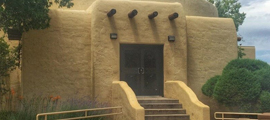THE KOSHARE KIVA: A DREAM COME TRUE
During a trip to Aztec National Monument in 1939, the Koshares heard the ranger tell the story of the prehistoric Indians who built the great ceremonial Kivas a thousand years ago. From that visit and other visits in 1941 and 1946, the boys resolved to invest surplus Koshare money in the building of a giant Kiva.
A Remarkable Room
When President Eisenhower visited the Koshare Kiva, he stated the ceiling was truly amazing as he stood at the center of the room and looked. Typically referred to as "the Kiva," the room is patterned after the kivas of the Southwest and is one of the most unique places to be found in America.
The main reason for the uniqueness is that the building was built through the dedicated efforts of the Koshare Indian Dancers - a Boy Scout group. The Kiva, used as the performance area for the Koshare Indian Dancers, is what most visitors view as the featured piece of the Koshare Indian Museum.
A Remarkable Room
The link between the dancer program and the Museum began by introducing the Koshare dancers to art and artifacts as well as noted artists throughout their tenure as a Koshare Indian dancer. The youth gained an appreciation of Native American and Southwestern art and soon began collecting and purchasing Native American Indian art and artifacts. In 1949, they built a replica of an authentic Pueblo Kiva in which to perform their dances and house their growing collection. Over the years, graduating Koshare classes purchased a piece of art to leave to the Museum on behalf of their senior class.
Largest Self-Supported Log Roof in the World
Six hundred and twenty logs, weighing over forty tons, span across a room sixty foot across and the roof is self-supporting. Architects claimed that such a log roof was impossible to construct, but that did not stop the roof from being built. How did the "impossible" become possible?
Damon Runyon asked an engineer who helped design the Golden Gate Bride to help compute the stress factor of the logs.
Runyon wore out three slide rules trying to figure out the stress factor for the logs and came to the conclusion that white pine poles would be the best solution for the weight.
While sitting for tea, an experiment was conducted by putting toothpicks across a teacup in varying layers. Buck Burshears and the Kiva contractor, Carl Hendren, figured this would be the best way to place the logs in the actual roof.
Most importantly they believed it was possible - even when most experts disagreed.
THE KIVA INDIAN MUSEUM: A WORLD CLASS COLLECTION
The link between the dancer program and the Museum began by introducing the Koshare dancers to art and artifacts as well as noted artists throughout their tenure as a Koshare Indian dancer. The youth gained an appreciation of Native American and Southwestern art and soon began collecting and purchasing Native American Indian art and artifacts. In 1949, they built a replica of an authentic Pueblo Kiva in which to perform their dances and house their growing collection. Over the years, graduating Koshare classes purchased a piece of art to leave to the Museum on behalf of their senior class.
We have had the privilege of having many archaeologists and museum directors visit our Kiva. These visitors are astounded at the collections we have and have pronounced our efforts one of the most interesting examples to be found any place in America. Most Scout Troops and Scout organizations operate on a shoe string and work diligently to make enough money to get by. However, here a group of Boy Scouts with dedicated leadership has purchased for our community a building, a museum, and a program that attracts interested people from all over the world.

